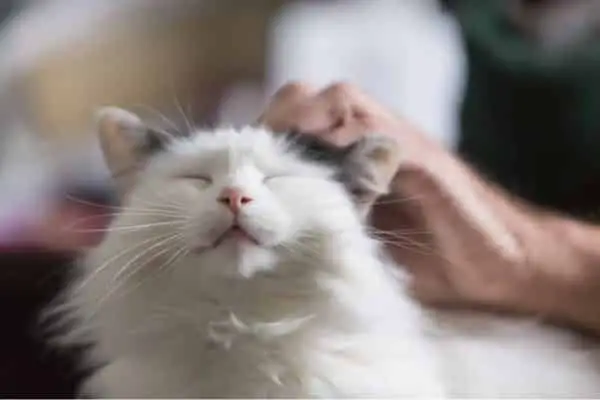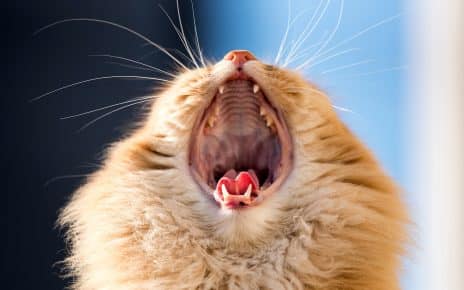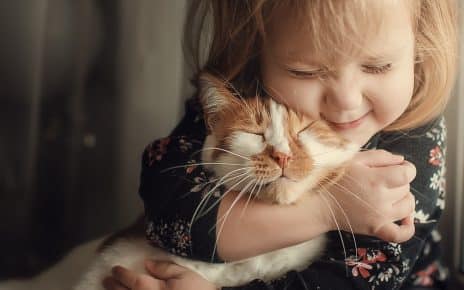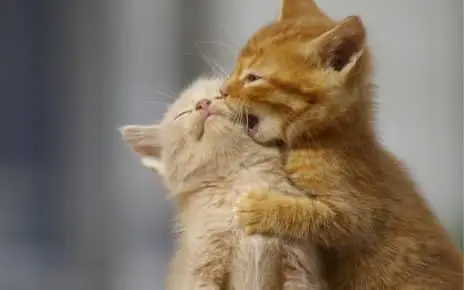It’s long been a misconception that a purring cat is, unequivocally, a happy cat. It’s generally a fairly safe assumption to make (they do purr when content), but it narrows down the scope of a purr.
If we assume it’s just a way for your cat to tell you that it’s happy, then it should be easy to make them purr whenever we want. But it isn’t.
That’s because purring denotes a whole host of different thoughts, emotions and feelings for your furry friend ? which makes it intrinsically difficult to force. Sometimes they may purr out of anxiety, or pain; other times it may be simply to communicate.
Luckily, with our list of methods, you’ll have a better chance of making your own loved cat purr and perhaps be able to turn the more nervous or anxious purrs into something a little bit happier!
What is a purr
First, let’s look at what a purr actually is.
A cat’s purring is an unmistakable sound; but it’s also a fairly strange one. Purrs are inherently different from a simple meow or mewl in that they also incorporate a physical aspect ? it isn’t just a sound, but also a vibration, a deep rumble coming from the depths of your kitty.
Nobody is quite certain about what produces a purr; but the general consensus is that it stems from the larynx and diaphragm, which have an effect over the vocal cords during a cat’s breathing cycle? This particular theory bears credibility due to cats with laryngeal damage or infections being unable to purr at all.
The technical bit out of the way, now we can get to the even less certain area of a purr’s purpose.
Happiness is a warm purr? Maybe not
It’s not much of a secret, whether you’re a cat owner or not, that a deep, satisfying purr is usually a sign that a cat is contended, comfortable or happy in a particular person’s company.
For the most part, a happy purr can be identified by other aspects of the animal’s body language: is it rubbing up against you? Weaving between your legs? Is its tail raised in a question mark-esque shape? Is it trying to head butt? you
All strong signs that the purr is a rumble of satisfaction.
But the purr is actually a much more detailed form of feline communication, stemming from the kitten’s birth. When new born cats arrive in the world, they are born both blind and deaf ? but do, of course, still have a sense of touch and can thus feel the vibrations of their mother’s purr.
The mother cat uses her deep, rumbling purr to attract the blind kittens towards her where they can nestle in for warmth, comfort and milk. After a few days of development the new born will begin to purr for itself, allowing mother and child to communicate with more nuance.
Hunger
Although cat hunger is usually characterized by meowing and knocking things off of your desk whilst you’re trying to work so you have money to put cat food on the table in the first place? purring can also be a huge indicator that your cat is looking for food.
Again, body language can be an invaluable tool in deciphering what your domestic fur ball is after; but the actual purr of a hungry cat will sound different in and of itself, and may be interspersed with small cries or mewling.
Healing
An increasingly interesting train of thought regarding cat purrs is that they actually have some healing qualities. You may have noticed that your cat tends to purr to itself when it is injured, upset or frightened (although, not as common as simply wailing through the pain).
When we say healing properties? it can basically be broken down into two categories
The first is that the physical feeling of purring can help to alleviate any stress or anxiety that the cat might be feeling (remember that cats are very prone to various types of anxiety and nervousness); this is often compared to how a new born baby might suck its thumb as a soothing mechanism.
The second is that the purr itself can actually vibrate at particular frequencies which help with healing damaged or broken bones, injured muscles and even reduce swelling of injuries ? this goes for both the animal itself, and any humans the cat may or may not be rubbing up against at the time.
So, you might want to think twice the next time you swat that purring kitten away from your face. You might miss out on all the lovely cat purr healing benefits.
Attention seeking
There’s a sort of golden mean running through the rules of cat ownership ? an unattainable balance. Cats are simultaneously one of the most neediest and clingy domestic pets that money can buy, whilst also being incredibly independent and huffy.
We don’t yet know where that delicate middle ground is; mankind is yet to transcend that particular horizon.
Like it or not, though, your cat likely knows how to play you like a puppet. Often a needy, or attention seeking cat will elicit a particular purr that can sound similar to a baby’s mewling or make you feel sorry for the fur ball.
The worst part? Even though you’re now hip to this little manipulative trick, you’ll still fall for it.
Kitty conference
The last and, perhaps, most simple explanation for a cat’s purring is that it’s simply trying to communicate with another of its kind.
Usually this behavior is reserved for older cats (read: more mature cats) that simply want to play or be friendly with a neighboring feline.
Of course, there’s no way to really tell what they’re talking about when they get together. Personally, I believe we’re on the cusp of some kind of clandestine feline takeover ? I tried to infiltrate my local circle of cats, but they knew I was wearing a wire.
Very embarrassing for all involved. My own cat won’t even look me in the eyes anymore. I don’t want to talk about it, to be honest. Please stop asking.
So there you have it; the humble purr may not be quite as simplistic as once thought. As mentioned above, it’s best to think about the situation as a whole, and your cat’s behavior and body language when trying to work out what they might mean by a particular purr.
Sometimes it’s clear as day, but often they like to make it as difficult as possible.
Encouraging the purr

For those unfamiliar with the versatility of the common cat purr, it might seem peculiar. Why would you want to make your cat purr, rather than just waiting for nature to take its course
Aside from simply enjoying the feeling of a rumbling kitty, purring also comes with a great range of healing benefits. This entails everything from improving breathing regulation to increased bone strength, from lower blood pressure to improved mental state of mind.
To have that kind of comfort on tap is the daydream of many a cat owner (and by that, I mean the nightly dream of cat obsessives ? you know who you are).
So, how do you make a cat purr? It’s all about knowing what makes a cat purr and then doing it…
Give them space

The easiest way to set the scene for your cat’s purring is to give them the space and freedom to explore your home and choose their own environment. The less strict you are with your cat, then the more relaxed he or she will be around you and in your space.
Granted, this often means that you need to sacrifice your pillow, lap, perfectly orchestrated living room seat or desk ? but it’ll be worth it when your cat settles into the space and begins that beautiful purr.
Soothe your cat

Whilst they are in a warm, comfortable space of their choosing, then it’s time to get close to them. This applies to both the physical and the more flowery feline emotional aspect of close .
If the cat is feeling safe and secure, then approaching it and stroking it gently will not upset its mood. By being softly physical with your fur ball, whilst it’s all snuggled up, you’ll bring the two of you closer and into a tighter bond, which will help to promote that loving purr whenever you cuddle up with him or her.
Bonus points for talking in a quiet, soothing voice when in the vicinity, too, as cats detest loud or uncommon noises? Despite making careers out of terrifying night time noises, themselves.
Spoil it from time to time

Cats are just like little children? and also adults, insomuch as they love to be spoiled. Now, spoiling your loveable fur machine is another one of the many delicate balancing acts that exist in the world of feline ownership.
Give them too many treats and they’ll start to expect them all the time and grow unruly when you don’t give it to them.
However, if you don’t treat them enough, they may begin to feel distant from you.
The art of spoiling a cat is to give it a special little food treat, new toy or a long play session, but doing so when it’s already comfortable and happy. This will solidify the bond between you and turn a regular, happy lazy Saturday into something extra special? Commence purring!
Make the most of all opportunities!

Sometimes you just need to sit back and wait for the weather to change ? you can’t always make your cat purr on command. The next best thing is to be prepared for it when it happens, and when it does? pounce!
Figuratively, not physically, or else you’ll lose an eye.
Wait for those purrs of attention, or comfort and then give him/her your full focus; play, rub, pat, stroke, cuddle, feed ? make the most of the opportunity.
Kitty pressure points

It’s easy to say stroke? or scratch? your cat and leave it as a general instruction, but if there’s one thing that experience and frustration have melded together to teach us, it’s that cats are incredibly picky.
When you go in for that rub or scratch, choose your cat’s favored spots. Now, all cats are different, but there are some rules of thumb that can be applied across the board until you know your own particular feline’s personality.
If they rub their head against you, then they’ll love a nice, gentle rub on the old noggin? and perhaps a scratch around the ears.
If your cat raises its head up, exposing its more vulnerable throat and underjaw area ? then it’s time to scratch its little cat-beard. This also applies to the tail ? a raised tail may be a heavy hint that your cat wants its backside scratched. It’s a tough job, but somebody’s got to do it.
If your cat frequently turns into a pancake and starfishes on its back, then you’re being given the ultimate invitation: to scratch and rub at its belly (one of a cat’s most vulnerable spots).
Differentiating depending on your cat’s mood or desire will mean that your little gestures of closeness will always hit the spot . From that point onwards, simply sit back and wait for those purrs to roll in.
Don’t chase them! Respect their space

Look, you might not want to hear this, but your cat’s been in touch with me. He asked me to tell you, on behalf of him, that he doesn’t always want to spend time with you. Sometimes he gets tired of the cuddles and the purring. He just needs some cat? time.
This is a key element for ensuring later purring and closeness between you and your cat. Think of it like an investment in the future.
No matter how much your cat loves that belly rub right now, and no matter how loud the purring is, it’ll eventually grow old and he’ll decide to walk away. Don’t chase after him! Let him go and wait for him to return to you later, when he’s ready for another cuddle.
Harassing your cat when it’s not in the mood is guaranteed to sour the relationship a little and put the kibosh on any immediate purring. Ever tried to hug your significant other straight after an argument? It’s useless.
Get to know it

The best way to make your cat purr is to study it. Don’t just assume that it’s cut from the same cloth as your friend’s cat, because it isn t.
Every cat has its own unique, and utterly bonkers, personality and the sooner you get to know it the sooner you’ll be able to recognise the signs and desires well enough to make it purr by doing specific things.



